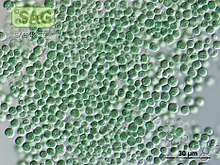Chroococcidiopsis
Chroococcidiopsis It is a photosynthetic, coccoidal bacterium and while a diversity of species and cultures exist within the genus,[3] with a diversity of phenotypes, some members of the order Chroococidiopsidales are known for their ability to survive harsh environmental conditions, including both high and low temperatures, ionizing radiation, and high salinity. Organisms capable of living in such harsh conditions are referred to as extremophiles.
| Chroococcidiopsis | |
|---|---|
| Scientific classification | |
| Domain: | Bacteria |
| Phylum: | Cyanobacteria |
| Class: | Cyanophyceae |
| Order: | Chroococcidiopsidales Komárek et al. 2014[1] |
| Family: | Chroococcidiopsidaceae Komárek et al. 2014[1] |
| Genus: | Chroococcidiopsis Geitler, 1933 |
| Type species | |
| Chroococcopsis gigantea Geitler, 1933 | |

Desiccation resistance
The ability of Chroococcidiopsis to resist desiccation in arid environments is due in part because it colonizes the underside of translucent rocks. The underside of these rocks provides enough condensed moisture for growth while the rock's translucent nature allows just enough light to reach the organism for photosynthesis to occur.
Mars colonization
Due to its resistance to harsh environmental conditions, especially low temperature, low moisture, and radiation tolerance, Chroococcidiopsis has been thought of as an organism capable of living on Mars. Scientists have speculated about the possibility of introducing Chroococcidiopsis to the Martian environment to aid in the formation of an aerobic environment. In addition to oxygen production, Chroococcidiopsis could aid in the formation of soil on the Martian surface. On Earth, soil is formed from the decomposition of organic matter. On Mars, because no organic matter is present, the organic material from the microbes themselves would provide the necessary organic matter. The soil and oxygen produced by these organisms could one day provide the conditions necessary for humans to grow food on Mars, possibly allowing for permanent human civilizations on the planet.[4][5] On a shorter time scale, cyanobacteria such as Chroococcidiopsis could be used in closed systems to produce resources for manned outposts on Mars without altering the planet's surface or atmosphere.[6]
A space mission called EXPOSE-R2 was launched on 24 July 2014 aboard the Russian Progress M-24M,[7] and was attached on 18 August 2014 outside the ISS on the Russian module Zvezda.[8] The experiment includes samples of Chroococcidiopsis that will be exposed to simulated Martian atmosphere, UVC radiation and temperature extremes.[9]
See also
References
- Komárek J, Kaštovský J, Mareš J, Johansen JR (2014). "Taxonomic classification of cyanoprokaryotes (cyanobacterial genera) 2014, using a polyphasic approach" (PDF). Preslia. 86: 295–335.
- Weird Low-Light Bacteria Could Potentially Thrive on Mars, Space.com, accessed 6/18/2018
- Cumbers, J.; Rothschild, L.J. (2014). "Salt Tolerance and Polyphyly in the Cyanobacterium Chroococcidiopsis (Pleurocapsales)". J. Phycol. 50 (3): 472–482. doi:10.1111/jpy.12169. PMID 26988320.
- "Greening of the Red Planet". NASA. Retrieved 2011-03-14.
- Billi, Daniela; Friedmann, Hoffer; Caiola, Ocampo-Friedmann (April 2000). "Ionizing-radiation resistance in the desiccation-tolerant cyanobacterium Chroococcidiopsis". Applied and Environmental Microbiology. 66 (4): 1489–1492. doi:10.1128/aem.66.4.1489-1492.2000. PMC 92012. PMID 10742231.
- Verseux, Cyprien; Baqué, Mickael; Lehto, Kirsi; de Vera, Jean-Pierre P.; Rothschild, Lynn J.; Billi, Daniela (2015-08-01). "Sustainable life support on Mars – the potential roles of cyanobacteria". International Journal of Astrobiology. FirstView: 65–92. Bibcode:2016IJAsB..15...65V. doi:10.1017/S147355041500021X. ISSN 1475-3006.
- Gronstal, Aaron L. (31 July 2014). "Exploring Mars in low Earth orbit". NASA's Astrobiology Magazine. Retrieved 2014-08-02.
- Kramer, Miriam (18 August 2014). "Russian Cosmonaut Tosses Satellite for Peru During Spacewalk". Space.com. Retrieved 2014-08-19.
- Baqué, Mickael; de Vera, Jean-Pierre; Rettberg, Petra & Billi, Daniela (20 August 2013). "The BOSS and BIOMEX space experiments on the EXPOSE-R2 mission: Endurance of the desert cyanobacterium Chroococcidiopsis under simulated space vacuum, Martian atmosphere, UVC radiation and temperature extremes". Acta Astronautica. 91: 180–186. Bibcode:2013AcAau..91..180B. doi:10.1016/j.actaastro.2013.05.015. ISSN 0094-5765. Retrieved 14 January 2014.